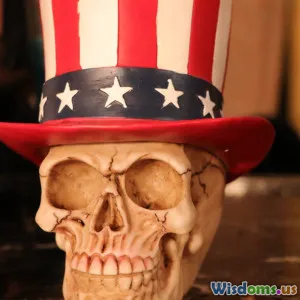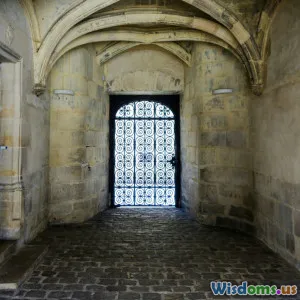
Five Surprising Traits All Secret Societies Tend to Share
8 min read Explore five unexpected traits common to secret societies that reveal their mysterious allure and influence throughout history. (0 Reviews)
Five Surprising Traits All Secret Societies Tend to Share
Secret societies have long fascinated historians, conspiracy theorists, and curious minds alike. From the enigmatic Freemasons to the shadowy Illuminati, these groups often appear wrapped in mystery and intrigue. But beyond the cloak-and-dagger image, many secret societies share unexpected traits that help explain their persistence and captivating nature. This article delves deep into five surprising characteristics common across secret societies, illustrating their roles, structures, and enduring appeal.
1. Elaborate Rituals and Ceremonies
One of the most distinctive characteristics of secret societies is their complex and often symbolic initiation rituals. These ceremonies serve multiple functions: they mark a member’s entry, reinforce shared values, and create a sense of unity that transcends ordinary social bonds.
Purpose of Rituals
Rituals create a transformative experience — individuals often describe feelings of profound change or rebirth. This psychological effect cements loyalty to the society and fosters a powerful group identity. For example, the Freemasons utilize a sequence of degrees, each with its own ritual, involving symbolic tools such as the square and compass. These symbols aren’t mere decorations but represent values such as integrity and morality.
Examples
- Freemasonry: Members undergo three classic degrees (Entered Apprentice, Fellowcraft, Master Mason), each with rituals involving allegorical narratives derived from stonemasonry.
- Skull and Bones: The Yale secret society engages new members in initiation rites shrouded in secrecy, rumored to include symbolic tests of loyalty and oaths.
Such rituals maintain an aura of mystique, helping societies perpetuate secrecy and exclusivity.
2. Symbolic Language and Iconography
Symbols are a universal means of conveying complex meanings hidden beneath their surface. Secret societies harness symbols to encode messages, denote membership, and conceal esoteric knowledge.
Why Symbols Matter
Symbols serve as a shared, non-verbal language that members recognize instantly but remain obscure to outsiders. This fosters a sense of belonging and separates initiates from non-members. Furthermore, the use of symbols imparts an air of antiquity and timeless wisdom, often linked to ancient traditions or spiritual beliefs.
Key Symbols Across Societies
- The Eye of Providence: Associated with the Illuminati and Freemasons, this symbol represents divine watchfulness and enlightenment.
- The Skull and Crossbones: Used by various secret groups to signify mortality, loyalty unto death, or secrecy.
- The Ouroboros (Serpent eating its own tail): Signifying eternity and cyclical nature, often used in alchemical contexts within esoteric societies.
The use of symbolism enables a rich tapestry of communication, reinforcing the society's values and legitimacy.
3. Extreme Secrecy and Confidentiality
A defining and unsurprising trait of secret societies is their level of secrecy. But this secrecy is often more strategic than purely protective—for internal cohesion and external identity.
Secrecy as Social Glue
The culture of confidentiality binds members together, producing trust but also generating intrigue and suspicion from outsiders. Meetings, membership rolls, and agendas are kept strictly confidential. This controlled information flow enhances prestige and protects the group’s influence.
Notable Examples
- The Illuminati: Known for purported shadowy influence, their secrecy fed many conspiracy theories but also protected their real network from scrutiny.
- The Odd Fellows: Despite community service efforts, many of their internal operations remain private, fostering curiosity and a sense of exclusiveness.
Secrecy helps secret societies manage their public image and internal dynamics, creating an exclusive world distinct from mainstream society.
4. Strict Membership Selection and Hierarchical Structure
Secret societies aren’t open clubs; they feature highly selective criteria for entry and often stringent hierarchical organization. This system underlines control, exclusivity, and discipline.
Membership Criteria
Admission can depend on lineage, profession, social standing, or nomination by existing members. This exclusivity ensures ideological alignment, loyalty, and social cachet, often elevating participants’ stature within broader society.
Hierarchy
Unequal rank structures, such as degrees or ranks, serve multiple purposes:
- Motivation: Members advance by merit or loyalty, encouraging commitment.
- Structure: Clear leadership and roles ensure operational efficacy.
For example, Freemasonry’s tiered degrees involve increasing knowledge and responsibilities. Similarly, the Order of the Eastern Star (related to Masons) follows a structured hierarchy reflecting symbolic teachings.
5. A Focus on Influence and Networking
Behind the secrecy and symbolism lies another key thread: secret societies excel at creating powerful networks that influence politics, business, and culture.
Network Power
Membership often includes individuals from influential families, governments, or corporations. This connection allows members to leverage social capital and facilitate cooperation beyond usual social or political boundaries.
Real-World Examples
- Bohemian Grove: A gathering place of political and business elites, this society’s annual retreat fosters informal alliances influencing US policy.
- The Bilderberg Group: Though not a traditional “secret society,” its secretive annual meetings among global elites parallel many traits discussed here, emphasizing networking and influence.
This networking function positions secret societies as subtle engines of power, often guiding decisions and shaping history away from the public eye.
Conclusion
Secret societies continue to captivate the imagination because they combine elements of mystery, ritual, and power. The five surprising traits explored here — elaborate rituals, rich symbolism, strict secrecy, hierarchical membership, and influential networks — form the backbone of their identity. These characteristics enable secret societies not just to survive for centuries but also to exert significant cultural and sometimes political influence.
Understanding these shared traits offers a window into why secret societies endure and why they evoke such fascination. They not only create a private world for their members but also tap into universal human desires for community, purpose, and authority.
Whether driven by myth or reality, the traits shared by secret societies reveal timeless patterns of human organization and belief, making their study endlessly intriguing for historians, sociologists, and curious individuals alike.
Rate the Post
User Reviews
Popular Posts




















